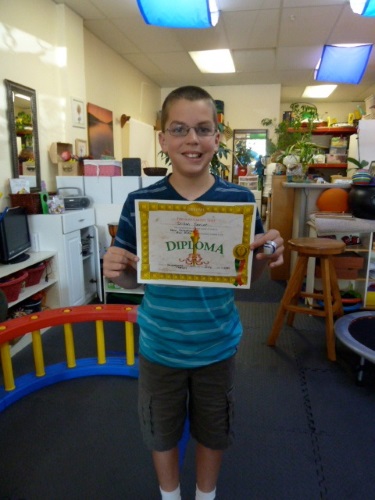 CASE STUDY
CASE STUDY
DILLON’S STORY
Read Full Study
As an Occupational Therapist, I have worked with my little clients most often to help them “catch up” with their development. While we cannot predict with certainty to what extent each child will have a successful outcome we do have a formula that we employ to help maximize their potential. Working with Dillon (and his village) over the many years that we worked together allowed me the rare professional privilege to develop and validate a successful clinical
approach. For this, and for the fortune of working with an amazing boy and his extraordinary family, I am eternally grateful.
I first met Dillon at his home in August 2005. For the most part, Dillon sat in the corner of his dining room, engaged with a toy and barely making any eye contact. At the time, he was 29 months old. His test scores fell within the 18-month-old age equivalency. Shortly after beginning his treatment sessions with Sande Rutstein, OTR/L, his parents requested that Dillon be seen for occupational therapy in the clinic setting. This would allow for more access to the varied sensory motor modalities, which would address and help to improve a wide range of his developmental skills. A pediatric occupational therapy clinic, if equipped properly, consists of specialized equipment used to work on improving balance, gross motor, upper limb coordination/ speed and dexterity, perceptual and fine motor skills. Every activity provided at New Directions for Kids is purposeful. Since play is their work, a child can make significant gains and catch up readily with their cognitive, developmental, and social skills. We create structured activities in a safe, sensory-rich environment that result in children’s ability to learn, grow, attend and behave.
 Children take in information from their environments via their senses (hearing, smell, taste, vision, feeling through touch, and the muscles and joints), which translate through neural pathways sending information to the brain. Sometimes the information does not remain direct on the pathways and the messages actually become like a traffic jam causing dramatic responses and emotional dysregulation. This information can be easily misinterpreted as misbehavior causing strong reactions, which can be either over or under reactions that others commonly misperceive as behavioral issues. In fact, these children aren’t misbehaving; they are challenged with Sensory Integration Disorder.
Children take in information from their environments via their senses (hearing, smell, taste, vision, feeling through touch, and the muscles and joints), which translate through neural pathways sending information to the brain. Sometimes the information does not remain direct on the pathways and the messages actually become like a traffic jam causing dramatic responses and emotional dysregulation. This information can be easily misinterpreted as misbehavior causing strong reactions, which can be either over or under reactions that others commonly misperceive as behavioral issues. In fact, these children aren’t misbehaving; they are challenged with Sensory Integration Disorder.
Much of my work with children and their families, caregivers and other concerned professionals centers on understanding Sensory Integration and Sensory Integration Disorder.
Sensory Integration is the neurological process of the central nervous system, which interprets, organizes and directs the sensory information coming in from the environment. It is as if there is a traffic policeman who locates, sorts and orders the sensations. For some this develops efficiently and the responses are normal. When the system does not develop efficiently the signals do not get organized and creates that traffic jam in the nervous system as mentioned above. The result is problems with arousal, attention and organizing behavior. These children are “Out of Sync” emotionally, socially, and behaviorally resulting in Sensory Processing Disorder when the sensations don’t communicate adequately with the brain. All of the seven (7) senses have to work together to have a normal response. As mentioned previously, the seven areas include sensory information coming in through sight, sound, smell, touch, taste, our sense of gravity with balance through the Vestibular system, and the Proprioceptive System via sensing information through the joints and muscles.
 Dillon’s nervous system was compromised and he easily reacted in a “flight/fright” mode. Children who struggle with Sensory Processing Disorder have a difficult time finding a balance with the incoming sensory information, which causes them to be either overesponsive or underesponsive. As was the case with Dillon, he overreacted to incoming sensory input, especially with auditory, touch, balance, and smell senses. Although he was resistant and fearful to engage in many items throughout the environment he would benefit from a Sensory Integration approach to treatment on a consistent basis. Allowing him to have exposure to the appropriate sensory input, right amount of frequency, and quantity would allows children to slowly adapt. Like most children, routine and structure were also key for Dillon. Transitions and changes have always been difficult for him and this difficulty is common for many children with Sensory Processing Disorder…Read Full Study
Dillon’s nervous system was compromised and he easily reacted in a “flight/fright” mode. Children who struggle with Sensory Processing Disorder have a difficult time finding a balance with the incoming sensory information, which causes them to be either overesponsive or underesponsive. As was the case with Dillon, he overreacted to incoming sensory input, especially with auditory, touch, balance, and smell senses. Although he was resistant and fearful to engage in many items throughout the environment he would benefit from a Sensory Integration approach to treatment on a consistent basis. Allowing him to have exposure to the appropriate sensory input, right amount of frequency, and quantity would allows children to slowly adapt. Like most children, routine and structure were also key for Dillon. Transitions and changes have always been difficult for him and this difficulty is common for many children with Sensory Processing Disorder…Read Full Study
